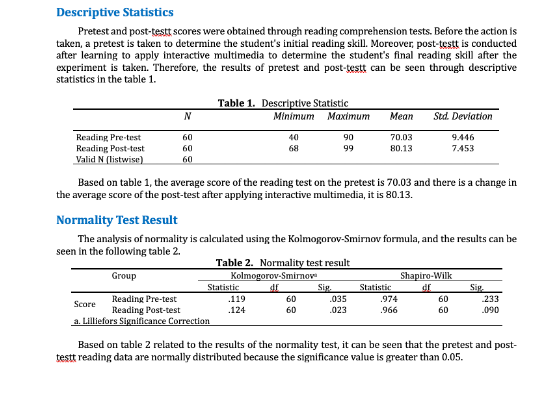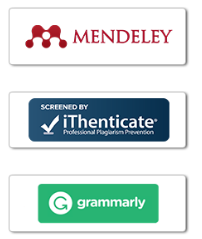The effects of interactive multimedia on students' reading skills
DOI:
https://doi.org/10.26555/bs.v45i1.1353Keywords:
Indonesian language, Interactive Multimedia, Reading Skill, StudentsAbstract
Mastering reading skill has an important role in the educational field. Therefore, the purpose of this study is to determine the effect of the interactive multimedia application on the reading skill in Indonesian language. This study is categorized as an experimental research design type, namely One Group Pretest Post-testt Design. The population in this study is the students of Primary School Teacher Education Department in Yogyakarta and Klaten. Then, the sample is the second-semester students of Widya Dharma University in Klaten and Sarjanawiyata Tamansiswa University in Yogyakarta. The students involved in this research are 60 students. Then, data are collected by using the Indonesian reading skill test in way applying interactive multimedia in learning Indonesian reading skills, which is conducted into two stages namely before (pretest) and after (post-testt). Then, data were analyzed using paired t-test. The results of this study show a significant increase in students' reading skills, which is evident in the average score, namely a pretest score of 70.03 and an average post-testt score of 80.13. Also, the results of the paired t-test show a significance value of 0.000 less than 0.05, it indicates that there is a significant difference between the pre-test scores and the post-test students reading scores. These results show that the application of interactive multimedia has an impact on improving students' reading skills, this is because interactive multimedia is not only a conventional learning media but is a technology-based learning media that is able to attract interest in learning and is interactive.
References
Ahmad, J., Sritharan, G., & Mohamad Nasir, N. N. A. (2015). The Effectiveness of Video and Pamphlets in Influencing Youth on Environmental Education. Jurnal Komunikasi, Malaysian Journal of Communication, 31(1), 281-296. https://doi.org/10.17576/JKMJC-2015-3101-15
Al-Adwan, A. S., & Smedley, J. (2022). The Impact of Multimodal Learning on Student Engagement and Outcomes. Journal of Computer Assisted Learning, 38(3), 825–840.
Asabere, N., & Enguah, S. (2012). Towards a Perspective of Information and Communication Technology (ICT) in Education: Migrating From Electronic Learning (E-Learning) to Mobile Learning (M-Learning). International Journal of Information and Communication Technology Research, 2, 55-61
Baceviciute, S., Terkildsen, T., & Makransky, G. (2021). Remediating Learning from Non-immersive to Immersive Media: Using EEG to Investigate the Effects of Environmental Embeddedness on Reading in Virtual Reality. Computers & Education, 164. https://doi.org/10.1016/j.compedu.2020.104122
Castles, A., Rastle, K., & Nation, K. (2018). Ending the Reading Wars: Reading Acquisition From Novice to Expert. Psychological Science in the Public Interest, 19(1), 5-51. https://doi.org/10.1177/1529100618772271
Clark, R.C., & Mayer, R.E. (2023). e-Learning and the Science of Instruction (6th ed.). Wiley.
Crawley, S. J., & Mountain, L. H. (1995). Strategies for guiding content reading (2nd ed). Allyn and Bacon.
Creswell, J. W. (2014). Research design: Qualitative, quantitative, and mixed methods approach (4th ed). SAGE Publications.
Daryanto, D. (2013). Effective Learning Innovation. Yrma Widya.
Dehaene, S. (2020). How We Learn: The New Science of Education and the Brain. Penguin.
Duke, N. K., & Cartwright, K. B. (2021). The Science of Reading Comprehension Instruction. International Literacy Association. https://doi.org/10.1002/trtr.1993
Fiorella, L., & Mayer, R. E. (2022). Multimedia Learning (3rd ed.). Cambridge University Press.
Fitrawati, F., Syarif, H., Zaim, M., & Perrodin, D. D. (2023). The perceptions of tertiary students and lecturers regarding CLIL-based critical reading material employing interactive multimedia. Indonesian Journal of Applied Linguistics, 12(3), 612-625. https://doi.org/10.17509/ijal.v12i3.36838
Hikmah, D. (2019). Media For Language Teaching and Learning in Digital Era. International Journal of English Education and Linguistics (IJoEEL), 1(2), 84-89 . DOI: https://doi.org/10.33650/ijoeel.v1i2.963
Hwang, H., & Duke, N.K. (2020). Content counts and motivation matters: Reading comprehension in third-grade students who are English learners. AERA Open, 6(1). DOI: https://doi.org/10.1177/2332858419899075
Ilhan, G. O., & Oruç, Ş. (2016). Effect of the use of multimedia on students' performance: A case study of social studies class. Educational Research and Reviews, 11 (8), 877-882. https://doi.org/ 10.5897/ERR2016.2741
Johannes, D., & Hashim, H. (2023). Investigating Multimedia Integration Among ESL Teachers in Teaching Reading Comprehension: A Systematic Literature Review. International Journal of Academic Research in Business and Social Sciences, 13(12), Pages-3808-3823. https://doi.org/10.6007/IJARBSS/v13-i12/20229
Kalyuga, S., & Sweller, J. (2021). The Redundancy Principle in Multimedia Learning', in The Cambridge Handbook of Multimedia Learning, Cambridge University Press, 212 – 220. http://dx.doi.org/10.1017/9781108894333.021
Kim, Y.S.G. (2020). Hierarchical and Dynamic Relations of Language and Cognitive Skills to Reading Comprehension. Journal of Educational Psychology, 112(4), 667-684. https://doi.org/10.1037/edu0000407
Lisnawati, I. (2021). Speaking Learning Based on Multimedia. Journal of language and Linguistic, 17(4), 2046-2056. https://doi.org/10.52462/jlls.147
Mayer, R.E. (2022). Multimedia Learning (4th ed.). Cambridge University Press.
Munir, M. (2012). Multimedia Konsep & Aplikasi dalam Pendidikan. CV Alfabeta.
Noetel, M., Griffith, S., Delaney, O., Harris, N. R., Sanders, T., Parker, P., del Pozo Cruz, B., & Lonsdale, C. (2021). Multimedia Design for Learning: An Overview of Reviews With Meta-Meta-Analysis. Review of Educational Research, 92(3), 413-454. https://doi.org/10.3102/00346543211052329
Norman, D.A. (2023). The Design of Everyday Things (Revised ed.). Basic Books.
Nur, A. H. & Ahmad, D. (2017). Improving Students' Reading Skill Through Interactive Approach at The First Grade of SMAN 1 Mare, Bone. ETERNAL (English, Teaching, Learning and Research Journal), 3, 44-56. https://doi.org/10.24252/Eternal.V31.2017.A5
Nurmahanani, I., Mulyati, Y., & Sastromiharjo, A. (2021). The Effectiveness of Interactive Multimedia Aided Social Cognitive Model for Early Reading Learning in Elementary School. RETORIKA: Jurnal Bahasa, Sastra, Dan Pengajarannya, 14(2). https://doi.org/10.26858/retorika.v14i2.18885
Novitasari, K., Zubaidah, E., Harjana, R., & Daniswari, H. P. (2020). Multimedia Technology to Stimulate Children's Literacy Ability: Study in Kindergarten in Sleman. Universal Journal of Educational Research, 8(12B), 8011-8016. https://doi.org/10.13189/ujer.2020.082601
Pannim, P., Suwannatthachote, P., Manowan, P., & Numprasertchai, S. (2022). Improving Reading Comprehension Skills Using Multimedia Storytelling with Mind Maps for Students with Learning Disabilities in Thailand. International Journal of Emerging Technologies in Learning (iJET), 17(08), 97-111. https://doi.org/10.3991/ijet.v17i08.10931
Patel, C. (2013). Use of Multimedia Technology in Teaching and Learning communication skill. International. Journal of Advancements in Research & Technology, 2 (7), 116-123.
Pettersson, R., & Scheiter, K. (2023). The Effects of Multiple Representations in Learning: A Meta-Analysis. Educational Research Review, 39, 100531.
Plass, J.L., et al. (2023). Handbook of Game-Based Learning. MIT Press.
Praheto, B. E., Andayani, A., Rohmadi, M., & Wardani, N. E. (2017). Peran Multimedia Interaktif dalam Pembelajaran Keterampilan Berbahasa Indonesia di PGSD. Proceedings Education and Language International Conference, 1(1). https://jurnal.unissula.ac.id/index.php/ELIC/article/view/1224
Praheto, B. E., Rohmadi, M., & Wardani, N. E. (2020). The Effectiveness of Interactive Multimedia in Learning Indonesian Language Skills in Higher Education. Rupkatha Journal on Interdisciplinary Studies in Humanities, 12(1). https://doi.org/10.21659/rupkatha.v12n1.34
Rayner, K. (2021). Eye Movements and Information Processing During Reading. Psychological Review, 128(3), 487-517.
Rogti, M. (2024). The Effect of Mobile-based Interactive Multimedia on Thinking Engagement and Cooperation. International Journal of Instruction, 17(1), 673-696. https://doi.org/10.29333/iji.2024.17135a
Ruomei, F., & Feng, M. (2012). The Use of Multimedia in Chinese Language Teaching at Binus University. Humaniora, 3(2), 392. https://doi.org/10.21512/humaniora.v3i2.3336
Share, D.L. (2021). Is the Science of Reading Just the Science of Reading English?. Reading Research Quarterly, 56(S1), S391-S402. https://doi.org/10.1002/rrq.401
Shneiderman, B., et al. (2022). Designing the User Interface (7th ed.). Pearson.
Subramanian, L. (2024). Role of Multimedia Resources in English Language Learning: An Overview. Integrated Journal for Research in Arts and Humanities, 4(1), 191-195. https://doi.org/10.55544/ijrah.4.1.28
Vaughan, T. (2011). Multimedia: Making it work (8th ed). McGraw-Hill.
Wong, R. M., Adesope, O. O., & Nesbit, J. C. (2024). Effects of Multimedia Instructional Strategies on Cognitive Load and Learning: A Meta-Analysis. Educational Psychology Review, 36(1), 1–28.
Zuchdi, D. (2013). Strategies to Improve Reading Ability. UNY Press.

Downloads
Published
Issue
Section
License
Copyright (c) 2025 Biya Ebi Praheto, Pramudya Cahyandaru, Mark Gabriel Wagan Aguilar

This work is licensed under a Creative Commons Attribution-ShareAlike 4.0 International License.

1.jpg)






